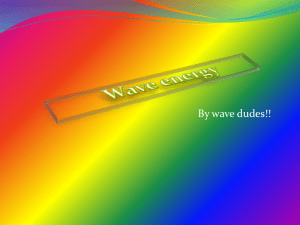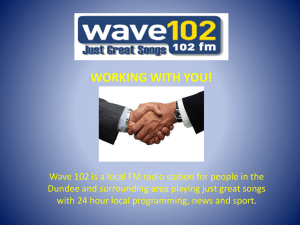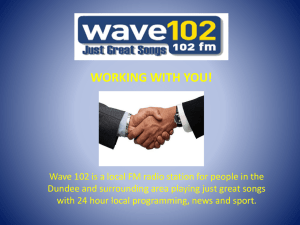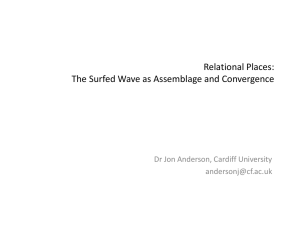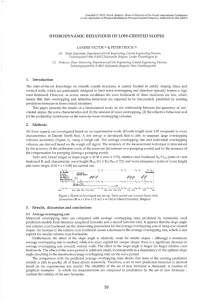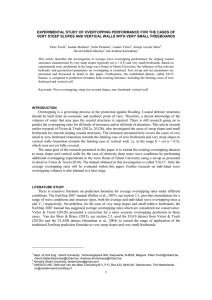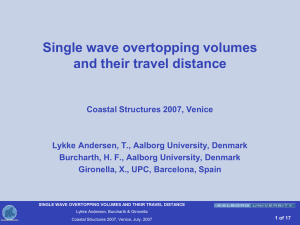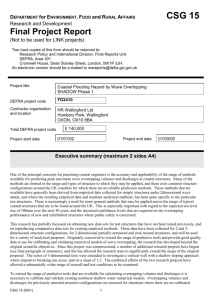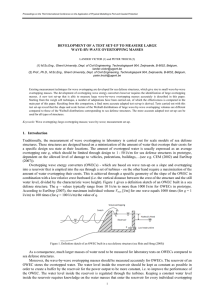A Detailed Look at Variable Local Flood Responses Krista Conner
advertisement
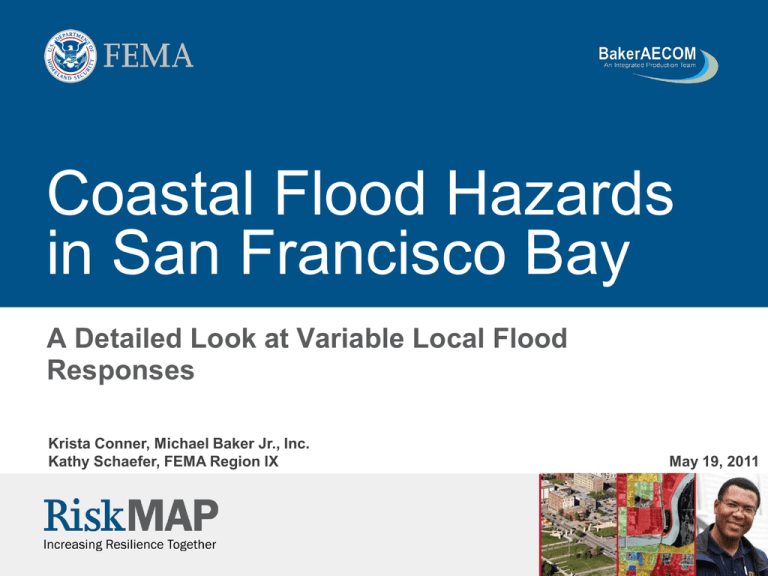
Coastal Flood Hazards in San Francisco Bay A Detailed Look at Variable Local Flood Responses Krista Conner, Michael Baker Jr., Inc. Kathy Schaefer, FEMA Region IX May 19, 2011 Overview Key Terminology Scope of Study Special Study Considerations Overland Coastal Flood Hazard Analysis Next Steps Conclusions Source: Aslak Raanes 2 Key Terminology Seas: Local wind-generated waves Swell: Long period waves originating from Pacific Ocean storms that enter SF Bay through Golden Gate Swell 3 Key Terminology Continued Overland Wave Hazard Analyses: Wave Propagation (WHAFIS), Runup, Overtopping Extreme Value Analysis (EVA): Statistical analysis to obtain 1%-annual-chance values Event-based study approach • A 1%-annual-chance event defined to calculate 1%-annual-chance flood • Typically, forcing from single source (e.g., hurricane) • Typically, elevated water levels and wave conditions coincident Response-based study approach • Many events evaluated for resulting flood “response” (overland waves and runup/overtopping) • Forcing from various sources (e.g., seas and swell) • Elevated water levels and wave conditions NOT coincident 4 Scope of Study Study Team Members • FEMA Region IX • FSG (Nolte and DHI) • BakerAECOM • NHC Study Area Scope • Regional MIKE 21 hydrodynamic and wave modeling • Extreme Value Analysis • Overland Coastal Flood Hazard Analyses • Mapping From Regional Coastal Hazard Modeling Study for North and Central San Francisco Bay (DHI, 2010) 5 Special Study Considerations Sheltered water body • Complex geometry Vertical Wall • Variable shoreline characteristics • Dense development and population Natural Shoreline Seas and swell waves Revetment • Born of different forcing • Temporal variability • Spatial variability • Directional variability Non-coincident peaks in water levels and waves 6 Overland Coastal Hazard Analyses Data sources Extreme Value Analysis year definition Runup and overtopping Overland wave propagation 7 Data Sources Topography and Bathymetry • Same as DHI study • FEMA LiDAR (Collected by Merrick 2004) • USACE 2003 Dredging Surveys • NOAA NOS GEODAS Bathymetric Survey Wind Speeds • OAK • SFO • Travis Air Force Base From Regional Coastal Hazard Modeling Study for North and Central San Francisco Bay (DHI, 2010) 8 Data Sources Continued Water Level and Wave Starting Conditions • DHI hydrodynamic and wave study results • 31-year time series extracted at points along the coast Land Use Information • Field reconnaissance • Aerial imagery From Regional Coastal Hazard Modeling Study for North and Central San Francisco Bay (DHI, 2010) 9 Extreme Value Analysis Seasonality in swell waves Calendar year does not ensure event independence “Storm year” definition: July 1- June 30 10 Runup and Overtopping Runup Methods • DIM—natural coast with slope < 1/8 • TAW—natural coast with slope ≥ 1/8; revetments • SPM—vertical walls Overtopping Method: Cox-Machemehl Overtopping Wave Runup Total Stillwater Wave Setup Surge Normal Bay-Level Shoreline 11 Runup and Overtopping Response-Based Approach Runup calculated each hourly time step for 31-year time series Waves filtered for “onshore” directionality Runup from seas, swell, and seas+swell evaluated 1% total water level (TWL) calculated by EVA of TWL annual maxima bluff or coastal structure limit of swash Runup Height Total Runup Wave Setup Surge 0ft, NAVD 12 TWL Runup and Overtopping: Overtopping Overtopping evaluated for single 1%-annual-chance “event” C-M Method required input parameters: • TWL Extended slope • Dynamic water level (DWL) Potential runup • Wave period Event defined as: TWL Overtopping bore Dynamic water level • 1%-annual-chance TWL • Maximum DWL of 31 TWL annual maxima • Average wave period from TWL annual maxima Overtopping Depth Overtopping Limit Static + dynamic setup SWEL α 0ft, NAVD 13 Overland Wave Propagation WHAFIS 4 Model Results from WHAFIS model used in flood hazard mapping: • Inland extent of inundation—SFHA boundary • Wave heights along transect—flood zone designations (VE and AE Zones) • Wave crest elevations along transect—BFEs Zone VE Zone AE Zone X SFHA Boundary Wave Crest Profile SWEL H = 3 ft Normal Bay Level 14 Overland Wave Propagation cont. Dual-event approach • Scenario 1: 1%-annual-chance water level w/appropriate wave • Scenario 2: 1%-annual-chance wave height w/appropriate water level Scenarios constrained by 1%-annual-chance wave crest elevation Seas and swell modeled separately Scenario 1 Scenario 2 15 Overland Wave Propagation cont. Wind speeds Marsh Grass • • Scenario 1: maximum wind Non-default vegetation types • Parameters defined from field survey • Spatial extent based on field survey and elevation (Goals Project, 2000)* associated with 31 SWEL annual maxima events • Scenario 2: maximum wind associated with 31 wave height annual maxima events • Only onshore vector component of Marsh Habitat Tidal Range Vegetation Type Salt Marsh Low MSLMHW Cord Grass Salt Marsh Mid MHWMHHW Pickleweed Salt Marsh High >MHHW Bulrush wind speed used From North San Francisco FEMA Mapping Vegetation Parameters for WHAFIS Modeling (NHC, 2010) *GOALS Project (2000). Baylands Ecosystem Species and Community Profiles: Life histories and environmental requirements of key plants, fish and wildlife. Prepared by the San Francisco Bay Area Wetlands Ecosystem Goals Project. P.R. Olofson, editor. San Francisco Bay Regional Water Quality Control Board, Oakland, CA. 16 Next Steps Overland wave hazard analyses for remaining counties Develop work maps Community meetings DFIRM production 17 Conclusions Various unique challenges • Presence of seas and swell • Decoupled water levels and waves • Extreme variability in shoreline characteristics Innovative study approaches developed to address challenges • Combined seas and swell with directional consideration • Definition of 1% overtopping event • Dual-event WHAFIS approach • Wind speed values for WHAFIS analysis 18 19


